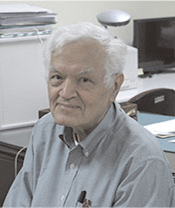| 發刊日期 |
2007年12月
|
|---|---|
| 標題 | 有朋自遠方來— 專訪James Glimm 教授 |
| 關鍵字 |
James Glimm, 專訪, 算子代數, C*代數, 量子力學, 量子場論, Peter Lax, 守恆律, Glimm scheme, 冪級數, 數值計算, 雙曲型偏微分方程, 演算法, 隨機選擇法(random choice method), inverse problem, 常微分方程, 路徑積分, Kurt Friedrichs, 小波(wavlet), Arthur Jaffe, Navier-Stokes方程式, Andrey Kolmogorov, 渦流, scaling, 固定點定理, 重整化群(renormalization group), Shock wave(截波,震波), Riemann問題, 資料科學, 模式識別(pattern recognition), 統計學, 生物數學
|
| 檔案下載 | |
| 全文 |
策 劃 : 劉太平 
格林 (James Glimm) 教授 1934 年生於伊利諾的 Peoria, 哥倫比亞大學 (Co-lumbia University) 1956 年學士, 1957 年碩士, 1959 年博士。 歷任麻省理工學院 (MIT)、紐約大學 (New York University)、洛克菲勒大學 (Rockefeller University) 教授。 現為紐約州立大學石溪分校 (SUNY at Stony Brook) 應用數學及統計系系主任, 目前擔任美國數學學會 (American Mathematical Society) 會長。 格林教授在 $C^*$-algebra, shock wave theory, quantum field theory, scientific computing 等數學科學的核心領域, 有開創性的重要貢獻。 格林教授為美國科學院院士, 得 Dannie Heineman Prize, Stelle Prize, National Medal of Science 等多項榮譽。 陳宜良(以下簡稱「陳」): 我想知道你從童年到研究所學習數學的經驗。 Glimm (以下簡稱「G」): 這是個好問題! 我一向數學都學得不錯, 但是其實我直到研究所才專業地學數學。 大學時我主修工程, 而事實上我是個中等生, 並不是個出色的學生。(笑) 劉太平(以下簡稱「劉」): 真的嗎? G: 我想我大概專精於很多"其它"的事, 比如說玩樂!(笑) 劉: 我聽說你做詩曾得過獎。 G: 沒有錯! 事實上我"其它"的興趣中包括寫詩。 我參加一個文學性的兄弟會, 恐怕我是被視為最不文藝的成員, 他們相當訝異竟是 Glimm 贏了文學獎。 陳: 詩的行道和數學很不一樣, 有時你必須以相當不同的方式跳過阻礙。 你解決守恆量問題的手法相當不同於傳統的方法。 G: 詩和數學是有共通之處, 都需要極度的專注, 但也有很多不同。 劉: 你玩得開心, 然後你進研究所 $\cdots$ G: 然後我心無旁鶩地全然專注於科學上的工作。差別有如日夜。 研究所時, 我深深地專注於科學。 劉: 你就決定要這樣? G: 我覺得那相當令人投入。大學的數學並沒引起我那樣大的興趣。 我並不是以數學家的角度去接觸數學, 而是以工程師的角度。 劉: 你怎麼能進好的研究所, 如果你說在大學時 $\cdots$ (笑) G: 啊! 那有一點點靠運氣。因為我在的哥倫比亞大學---有好的研究所, 但在入學上並沒那麼嚴苛。(笑) G: 所以, 在這點上我是非常非常地幸運。 要是我是在普林斯頓大學, 他們可能不會讓我入學, 而我可能就不會像現在這樣成為數學家。 尤釋賢(以下簡稱「尤」): 我想知道你是如何決定要投入哪一個領域? G: 啊! 在我的一生中有多方面的運氣。 哥倫比亞大學有些有活力的教授, 有位叫 Dick Kadison, 我和他聯絡上。 他在做算子代數, 所以我早期做算子代數方面的工作。我對數學和其應用的關係很感興趣。 算子代數關連到量子力學, 因此我就研究量子力學, 這是我追求應用的方式。 然後, 我去了紐約大學, 和 Peter Lax 談。我請 Peter Lax 建議些好問題。 他建議雙曲守恆律 (hypabolic conservation laws), 所以我就研究雙曲守恆律, 而有了所謂的 Glimm 方法 (Glimm schema) 的發現。 人們常常問這方法到底是如何形成的, 事實上它分為兩部份---數值演算法和估計, 估計必然是先要有的, 我基本的想法是有個冪級數。 冪級數是以波的交互作用為單位來展開。波會作用一次、又兩次、再三次、四次。 假使波很小, 那麼二次交互作用將會小於一次, 然後四次交互作用會小於三次。 所以級數預期會收斂, 就好比 Neumann 級數, 線性問題用 Neumann 級數來解決, 非線性問題我們將 Neumann 級數推廣。 這肯定是個正確的圖像而且是證明的基礎, 而我現在需要一個估計來證明這個觀念上的圖像。 我需要一個數值估計, 我極為努力的去做。那些估計基本上都失敗, 整個夏天, 一個想法接著另一個, 都不成。 我用的是收縮映射的概念。我由球的角度來思考估計: 交互作用後, 解應該要落在更小的球內, 而會待在某個球內, 所以有界。 當然, 這是個非線性問題, 你可以選擇你所謂的球的定義。所以可以用各式各樣的拓樸。 主要是要定義一種距離, 能讓交互作用後使這個距離變小。但就找不到這樣的距離。 我試了一個又一個, 所有的這些球, 所有這些球的定義, 沒一個能用。 最後, 正在打算放棄時, 我終於才試了非線性泛函。 那是個完全不同的定義, 而當有越來越多的交互作用, 非線性泛函果真越來越小。 因為所有該有的因素你都可以置入泛函裡, 當交互作用發生時你知道如何計算它。 而且這些估計收斂地很好, 是相當簡單的一組估計。 當這些都完成了, 我需要個建構性的程序。我已有的估計是某個程序的估計, 但我沒有那個程序。 所以我找到了估計, 但是沒有可以應用這些估計的程序。那個程序就是機率性的數值方法---它事實上相當簡單。 在那個時間點, 一兩天就做出來了。 因為你取之於伴隨估計而來的所有想法。 什麼是產生這些估計的載具? 這事實上很簡單, 那就是隨機選擇法 (random choice method)。 劉: 所以難的地方是在於估計和泛函, 結果你自然就找到了演算法。 G: 演算法本身是簡單的部份, 但簡單是由於難的部份已經被解決了。 劉: 到那個時候你已經有很多的洞見。 G: 是呀! 劉: 很多人在想到底Glimm是怎麼能想到這機率性的推論。到底答案是什麼? G: 這個解答其實很簡單, 但是之所以簡單只因為那是能乘載估計的載具, 而估計已經在那兒。 次序並不是反過來的, 所以估計先出現, 估計總要是估計某些東西, 我不知道那能估計些什麼。 所以我是在看一個逆問題, 我在看這估計能估計的到底是什麼。 陳: 讓我講個我的故事。在 1982 年我見過 Ron DiPerna。 他告訴我他在做補償緊緻 (Compensted Compactness), 他問我有沒有看過 Glimm 在隨機選擇法上的文章。 我說有, 我讀了你的文章, 也讀了太平的文章。我告訴他我讀了三遍。 他說:「只讀了三遍! 那不夠! 」 「你大概要讀十遍。」所以我回去再努力研讀。 劉: 這不一定是正確的忠告。 陳: 但我非常努力地研讀而且了解了, 我欣賞珍惜非線性交互作用和雙曲性的使用。 G: 我必須說其它人, 你、太平、和 Bressan, 取了這想法而且走得更遠。 Peter Lax 和我有原始的想法, 我們做了相當複雜的估計。但在一個觀念的背後總是有些很簡單的東西。 那是一個常微分方程, 遞減常微分方程。如果你想到那個常微分方程, 一切都會變得很簡單, 剩下的只要做很多技術上的估計來實現這些想法。 另一個我非常努力去嘗試而沒有結果的問題, 就是唯一性, 適定的問題。 這些後來才出現的想法, 闡明延伸, 絕對引進了我沒有的想法。 劉: Jim, 讓我們回到釋賢先前的問題。 那個問題似乎隱含著下面的意思: 當你進入一個新領域, 你似乎全然無懼, 是吧? G: 是的! 劉: 事實上 Peter Lax 和我講的故事跟你剛剛講的有小小的出入。 Peter Lax 說你問他什麼是守恆律中最難的問題。(笑) 所以, 你是全然地無懼。 那是一個你不熟悉的領域, 你看起來沒有心理上的障礙。 「這是我一點都不了解的領域, 沒有問題!」 G: 事實上簡單的問題給我更多的困擾。(笑) 因為有太多的選擇, 太多的方法。 簡單的問題沒有 高度的規範。 難的問題有它自己的路, 如果你選錯了路, 你就會脫離了正軌。 尤: 你怎麼能那麼確定你選對了路? G: 嗯, 事實上我那時並沒有選對。我花了一整個夏天在錯的路上。我就要放棄了, 但是我就再多試了那麼一點。 那是好的情況, 在我快放棄時, 我知道自己在做的東西中有某些非常基本 上的錯誤, 這給了我試其它方法的自由。 其實難的是要有整體、全面的準備, 這樣我思緒才能進到正確框架裡, 才能了解所有的事情。 在這些都已經在我腦袋裡時, 我知道要怎麼做。 尤: 那是說, 在你做出估計前, 你已經瞭解解應該是什麼, 以及解的完整的圖像, 以此來構築那些估計。 G: 我視其為波交互作用的冪級數。我認為波是最基本的元素, 所以解應該能以波交互作用來表示。 我視其為冪級數, 一列小的波的次方, 那應該要收斂, 因為高次交互作用相較於基本交互作用應該有較小的影響。 劉: 波和交互作用。 G: 是的! 劉: 我能換個話題, 你如何進入量子場論 (quantum field theory) 的? G: 嗯, 那是因為我做 $C^*$代數 ($C^*$-algebra) 學位論文後, 想尋找它們到底在哪裡有用, 基本上, 這就導向量子場論。 $C^*$ 代數曾被用來研究量子場論。 進入量子場論後, 我發現 $C^*$ 代數是可以用的工具, 但大概不是最合適的工具, 其它方法確實比較好。 所以我一開始順著一條路走, 發現雖然這是條可以走下去的路, 但有更好的路。 所以我們轉換方法, 基本的方法, 就是用路徑積分, 這比算子代數更基礎, 問題的解更平易。 當時算子代數派和路徑積分派之間有很多的爭議。事實上, 在這兩派之外有更多其它的手法。 當年在泛函分析家中, 有五、六個人每個人都有自己的理論和要怎麼做。 我從每一個人身上學到東西, 他們各執真理的一部份。與其爭論, 我就只說: 「是的。」 我說我向你學了東西, 然後, 我去找另一個人和他學東西。 我向五、六個人學, 他們之間每個人爭得你死我活, 但我和所有的人都學。 把所有的想法融合在一起, 再加入些新的想法, 之前沒人想到要這樣做。 劉: 我知道了, 然後那些東西在你腦裡發酵。 G: 是的, 是的, Friedrichs 有非常深刻, 很好的想法。 劉: 他寫了一本書, 是吧? G: 是的, 我讀了他的書, 那本書很好, 對我的工作有很大的影響。 但書的本身基本上非常接近物理學家的想法, 它並不大膽嘗試, 也不原創。 而那或許是個對的方向, 因為比較會大膽嘗試的人, 為了要大膽嘗試, 可能岔離了正道。 劉: 這工作, 人們總是敬仰並認為非常地深刻。你能不能深入一些技術層面。 G: 這工作有趣的一點是和小波理論有關。好吧, 很多人早在小波 (wavelets) 理論被發明前就發明了它, 所以我並不想在這上面大作文章。 舉例來說 Haar 在人們知道什麼是小波之前就發明了小波; 而 Jaffe 和我也是小波的前發明者。 所以我們能同時分析 $X$ 和 $P$ 空間。當時人們能做其一, 不能兼顧。 同時分析兩者, 使我們能做深得多的估計, 我們需要這些估計。 然而正式的物理法則, 冪級數展開, 向 Friedrichs 學到的想法, 這些大概都已經出現在 Feyman 和其他人的想法中。 但我們是向 Friedrichs 學的, 所以他對我們有很大的影響。 我們可以作冪級數展開, 而冪級數以和守恆律中一樣的方式, 可以做為首項。有一些無限大必須消去。 我們看較簡單的低維度問題, 這樣只有少數的無限大的項。只要消去這些少數的無限大, 剩下的都有限。 所以, 在 Friedrichs 的公式中你可以看出如何做低維度的消去。 這想法相當有趣, 有時你的答案會落在不同的希爾柏特空間 (Hilbert space)。 你從一個空間出發, 答案落在差了無限大的量的另一個空間。 但是消去少數無限大後, 你可以寫下該在的空間, 或經由適當的表法使剩下的有限且不改變空間。 所以我們能做所有這些事: 一旦你了解了, 就只是照著某個固定模式去做。 除了需要處理極大量的技術性問題, 基本上是相當制式的工作。所以論文有時五十頁, 有時一百五十頁。 Arthur Jaffe的學生有一種度量, 那是以計算紙作單位, 在那個年代計算紙是相當大張的, 大概兩英尺乘三英尺, 看看到底需要多少頁這樣大張的紙, 才能證明某個估計。只要有個統一的想法可以一貫到底, 一個簡單的想法做為綱領。 我想很多現代數學的發展關鍵也是如此。舉例而言, Poincare 猜想, 我沒有探究細節, 但是我相信 Perelman 在腦中先有些簡單的想法, 他能靠一串需要拼湊在一起的非常複雜的估計, 將這個想法實現。 劉: 我知道你興趣很廣。當你和化學家談, 你有話說。當你和主修商業的人談, 你又有別的話說。 你興趣非常廣, 我們剛提過你贏了詩的文學獎。然而在另一方面, 當你心在某件事上, 你有很深的專注力。 G: 是的! 為了做些深刻的工作, 必須專注。但是為了了解概念, 廣泛的涉獵是必要的。 所以你必須能夠有時候深, 有時候廣。 劉: 你有辦法這樣做呀!(笑) G: 那是做數學的樂趣之一, 數學容許其發生。 劉: 你一定有苦思不得的時候, 沒有嗎? G: 當然有啦! (笑) 當然有! 有很多我試過也沒做出來的。但偶而贏過別人, 也是爽快的。 尤: 你能不能給我們一些, 連偉大的 Glimm 都感到做不出來的問題? 讓我們好過些。(笑) G: 嗯, 分析上還沒解決的大問題之一是 Navier-Stokes 方程。 我相信那要依靠由重整群 (renormalization group) 來的想法。 重整群在物理上被提出來的時候, 分幾個階段, 但最深刻的部份是積分掉一些自由度。 先在較小尺度能解, 這導出在大尺度的簡化方程。 在所有都是均相的情況---那是你在渦流初期所預期看到的, 所有尺度都完全相同。 以歸納法, 假如你能做其中之一, 你就所有都能做。 這是個很簡單的想法, Kolmogorov 就用這來導出 $5/3$ 定律。 他的分析基於固定點分析, 重整群的固定點分析。 事實上有更進一步的想法和 $\varepsilon$-展開有關。可用在得到固定點方程之後解方程上。 我認為那部分不見得可用在 Navier-Stokes 方程的數學的存在性和平滑性的證明。 Orzag曾嘗試過, 但我不確定那部份會是重要。 可是重整群和它早期的意義, 必定是尺度的不變量分析, 我認為那將構成 Navier-Stokes 方程的存在平滑性的最終證明的重要部份。 陳: 你為什麼跳入計算科學的領域? G: 這是個好問題, 我一直或多或少對計算有興趣。每次我看它, 和計算的人談, 他們總是說極可能真的解決所有的問題。 我注意到這個情形持續了好幾年, 下一年他們總還有些其它的事做。 我想他們聲稱能解決了所有的問題, 可能言過其實。 或許還有些東西有待解決。因此我有興趣介入, 但是學習曲線大, 這到底是個問題。 要找個較友善的方式介入, 而且快點介入。 我那時注意到有人用隨機選擇法 (random choice method, Glimm 模式), 得到方程的數值解, 然而我只考慮把這個方法用在理論上。 我既然懂隨機選擇法, 所以就決定以它介入守恆律。 對一維這是個很好的方法, 但對三維, 所有的努力都沒有成功。 我想, 做三維數值黎曼問題的人造了些人為的問題。 我不是想對別人的計劃提出負面評價, 但我不覺得我必須關心這些事。 然而從高維度的波交互作用的角度來看, 我的確喜歡這些問題, 可以把它看為和馬赫波 (Mach-stem) 的形成和震波的反射等等有關。 我們從隨機選擇法做個較簡單的一維版本。是個較低次的方法, 而能得到較高的精確度。 在疏的網格, 這方法某方面而言是好的, 你得到有好性質的好解答。然後試著在二維上做, 簡直是個災難! 我們想過界面追跡法 (front tracking) 做為高維度的推廣, 那是我們遵循的方法。 這和波交互做用很有關。 我們用黎曼問題, 但是要做高維度的黎曼問題, 你必須解決震波極化 (shock polar) 的事情, 而那非常複雜。 所以, 你只得問: 「嗯! 這值得嗎? 」 我們看到有限差分法, 用在震波上表現得相當不錯。 所以不值得, 我們也就不再追跡震波。但我們仍然追跡接觸波 (track contacts), 問題是到底值不值得追跡接觸波。 事實上, 接觸波對有限差分法是個大災難, 是個主要未解的問題。 所以, 人們在接觸波上花了很大的工夫, 但問題依然沒有解決。比較於其它方法, 界面追跡法相當有前途。 人們有其它方法用來計算接觸波, 但是界面追跡法相當有前途。 劉: 你目前有那些數學之外的興趣? G: 數學之外的興趣? 聽歌劇是我的興趣之一, 另外我最近比較熱衷的是學義大利文。 這兩者是相關的, 因為很多歌劇是用優美的義大利文唱的。所以, 我想我要是能在義大利文上有更多的知識, 我便更會享受歌劇。 我是如何學義大利文的呢? 我讀義大利文書, 用義大利文在網上搜尋, 這樣學。我閱讀義大利文有中等程度。 我沒有學怎麼"說"。就"聽"和"了解"而言, 我找到一個義大利文電視頻道, 可以有某種程度的了解。但說義大利話還不流利。 劉: 你現在是美國數學學會的會長。這當然是個工作, 佔去你作科學的時間。 你一定對某些事感觸很深, 有某些事你想要去做, 不然你不會接這個工作。 G: 是的, 大概不可能沒有一些目標。然而, 有太多的目標就好比沒有。 如果你那個方向都要去, 結果可能一個方向也去不成, 因為都抵消了, 過程中總會有外力的介入, 可能合力為零。 所以, 我選定兩個目標, 學術上的目標和比較行政上的目標。 我們先談行政上的目標, 這和教學有關。以美國數學學會會長的身份, 我必須考慮到資源問題。 談到資源, 人們一般想到的是國家科學基金 (National Science Foundation) 或聯邦政府支持研究的基金。 事實上, 純數學最大的支持來自於大學師資的預算。 相對國家科學基金投入的每一塊錢, 大學預算是它的五到十倍。 以此而言教學預算比研究預算大一個量級, 教學更深遠重要得多。 國家科學基金還是重要, 非常重要, 但是扮演第二要角。 事實上, 如果你第一個工作---教學---做得好, 你第二個工作 ---研究---大概會做得更好, 我不覺得會有衝突。 我想看到教學進步。 現在, 在我的學校, 紐約大學石溪分校 (Stony Brook), 我們達成了這個目標。我認為這是獨一無二的。 據我所知, 教學在以研究為主的系所中是以如下的方式做的: 我們沒有衡量學習品質的量尺, 我們研究滿意度。 就學生滿意度而言, 我們的數學達到大學平均。 我不認為有很多的研究性大學能達到我們這個水準, 大概有很多的教學性大學能達到。 所以, 看來是可以達到有品質的教學而不必折衷研究。 我相信我們在數學和應用數學上研究做得很好, 那的確是需要些額外的財力, 大概是額外的 5%$\sim$10%。 無疑地大學可以補貼這些錢。大部份我用的方法也許不能推廣, 但是有些的確可以推廣。 我們在找尋一般能用的方法來改進美國數學家的教學能力。 那個銀質子彈在哪兒? 當羅徹斯特大學 (Rochester University) 的數學系曾面臨關門的危機時, 如他們說的, 絞刑的威脅讓人思緒專注。 他們發展了家庭作業電腦評分系統, 很顯然地那方法對學習成就造成驚人的改變。 所以, 我們要向他們學習。 我們有大約八個分布於不同科系的人, 我們看看他們能蹦出什麼樣的想法, 我希望能蹦出最好的想法。 其他組織在推他們的想法, 我們或許會幫助推廣。 在推行一些想法上, 我們會和別人合作, 而不是排斥。 我想像把所有找得到的想法標在平面上, 一個軸標示想法實施的難易度, 另一軸標示想法的成效。 所以, 我們的目標在左上角, 我們將填滿左上角。 那就是可行、簡單、 又有效的方法, 我們將推動這些想法做為教學問題的解答。 劉: 喔! 這是門實驗科學。 G: 是的, 這是行政上的目標。 學術上的目標和我個人研究方向相當不同, 我本身的研究其想法源於工程、物理科學、 和數學。 我發現很多的研究與以物理為基礎的模型無關, 他們基本上直接由數據出發。 舉個例子, 當你做影像分析、人臉識別、指紋識別、統計分析數據時, 通常不經由中介的微分方程, 你直接看著數據本身和數據中的模式。這就是我所謂的數據導向科學。 現在很多的科學考慮到數據分析, 即使有一些微分方程, 數據導向科學並不著重在這些方程上。 在這個手法下, 只注意數據, 讓數據為自己說話。而且, 在很多的情況下, 數學果真提供了要怎麼做的指導原則。 我覺得發展數據導向科學是件好事, 很可能成為二十一世紀的科學。 並不是說以物理, 微分方程為基礎的科學會消失。 但是在電腦時代, 模式識別 (patterm recognition) 是被低估了, 下個世紀那將變得很重要。 我想要探索那個方向, 至少以知識的眼光看看它會走出什麼樣的天地。 陳: 這是不是和統計科學比較有關? G: 這必然有很大的統計成份在, 但也有其它的成份。它本身不是統計 , 但和其它的聯結在一起。 我和耶魯大學幾個人談, 他們在發展這樣的想法。他們對由幾何導出的統計方程有興趣。 有一組數據, 這一組數據形成一個幾何流型, 但是是一個統計上的流型, 所以你必須找出埋 在統計數據裡的流型。 有一些幾何, 有一些統計。那如何在統計上的流型定義曲率? 我認為很多的數據導向科學上的問題是由組合的恆等式定義。再重申一遍, 那是找尋統計上的模式, 數據的模式。 人們使用守恆律在影像分析上, 舉例而言, 用黏性方法試圖達到收斂到淹沒在數據裡的模式。 所以我認為有空間讓很多不同的想法去發揮。 當然統計有很大的份量, 但我們不該先入為主將想法拘泥在這上面。 我們應該從一個廣闊的地平, 來看到底是那些領域的數學能用在模式識別問題上。 劉: 那不是個特定的主題, 那是思考的模式, 才剛開始。 G: 是的。 陳: 你修了哪些工程課程? G: 我從來就沒有以工程師的身份畢業, 但是我曾經是電機工程的學生。 那是個五年的學程, 但四年後我發現我的心不在那裡。 那時我非常的困惑, 我徬徨於物理、數學、和工程之間。 當時不知道為何困惑, 但現在我知道了。 因為我三個都想做, 我看到不同的東西, 但我只有做其中之一的精力而想三個都做。 所以我做不到, 當然我做不到, 我非得做出抉擇。 結果最後我以時間平均而不是空間平均達成了, 在不同時間做物理、數學和工程。 劉: 時間平均。你做計算, 做預測, 現在你談脈絡識別, 你和越來越多的人接觸, 是吧? G: 是的。 尤: 如果你能從頭來過再做大學生, 你會做什麼? G: 這是個好問題。當系主任, 我每年都可以重頭來過。 每年有些人離開, 我們聘請新的人, 所以我們每年重新來過。每年重新清理我的思緒。 我們發展怎樣的方向? 我們發展數學生物, 我們大概會發展金融數學。 我想這算是回答了你的問題, 我的確每年重新開始。 尤: 當你思路受阻時, 你如何突破? G: 嗯, 我想多年來生物數學成長許多, 現在很健康。 但我在多年前開始看這個領域時, 數學家的態度是: 「我不太確定什麼是生物, 但至少我們知道我們在做數學。」那真是個災難。 要做生 物, 你非得真的懂生物, 運氣好的話, 有些數學在裡頭。 所以, 我們非常深入了解生物。 我們做的大多是分子生物, 有原子層級的模型, 解牛頓方程, 有模式識別試著找出和其它分子作用的分子, 微分方程試著描繪在基因調節下基因和基因的交互作用。 這些不是我做的研究, 這是我的同仁做的。有很多事在進行。 如果我們要聘人, 我們要聘能力強的人, 快樂的人, 可以和其它能力強且快樂的人共事的人。 能這樣走下去, 我們或許會更好。我想這是我們能追尋的機會。 劉: 多美好的願景, 非常感謝你! ---本文訪問者劉太平任職於中央研究院數學所, 陳宜良任教於台灣大學數學系, 尤釋賢任教於新加坡大學, 整理者陳逸昆為馬利蘭博士生--- |
2007年12月 31卷4期
有朋自遠方來— 專訪James Glimm 教授

